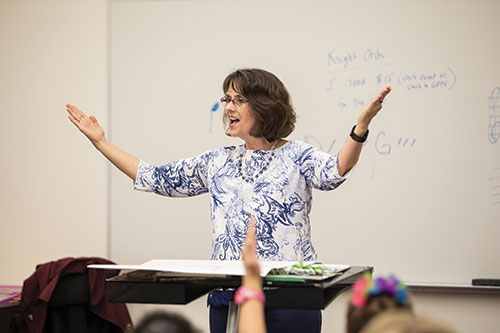“Hi! I have a huge favor to ask you.”
Pursuing a music education degree requires college students to prepare to teach in a variety of settings. Everyone dreams of an ideal teaching position that draws on our strengths and interests. In reality, your job might offer some surprises, such as elementary general music classes in addition to teaching middle or high school band, orchestra, or choir. If you have focused on directing performance groups, how can you accomplish more than just surviving the school year? Let the titles of some classic rock songs be your guide.

Show Me the Way (Peter Frampton)
At the start of any journey, a map is essential. Two maps that will help plan a journey into teaching elementary general music are standards and a scope and sequence. Using these tools helps educators determine the next steps based on the skills and knowledge students currently possess. This ensures a sequential educational plan for students, which can lead to greater student achievement.
It is important to determine reasonable expectations for each grade of elementary students in general music, and those answers can be found in current standards or a well-structured scope and sequence. Music education standards adopted by states and local school districts often rely on currently implemented national standards. These documents usually can be found online
An updated music textbook can guide a new elementary general music educator through the planning process. A framework of skills and knowledge development for each grade can be found in the teacher’s materials of any published curriculum. This document will be based on the national music content standards as well. Contacting the curriculum’s publisher and visiting with their representatives can provide guidance in using the materials wisely. If a music series is available, make it the foundation of your instruction. It will contain lesson materials and lesson ideas, but it will also provide a sequential structure for that grade level.
If the school has outdated or no teacher resources, local and national standards become especially important in the search for teaching ideas. There are also numerous online resources that offer suggestions for lessons. (See box on p. 11)
Elementary general music educators often have extra training in the Orff and Kodaly methodologies. Materials focused on these approaches can provide solid learning activities for children. Many publishers produce teacher resources with a variety of lessons to guide educators. Avoid creating a curriculum with a collection of haphazard lessons that lack a proper sequence. Remember that the burning questions to answer center on the music skills and knowledge that students should master at every step of each year. The answers to these questions will guide the creation of lesson plans that will provide logical and sequential learning for children.
Come Together (The Beatles)
I can still hear the voice of Glenna Rundell, my elementary music professor from the University of North Dakota: “Failing to plan is like planning to fail.” Through my decades of teaching, this mantra has proven true. Students, especially the younger ones, can be masterful at frustrating a teacher without a clear plan.
While there are numerous lesson plan templates, the best choice is one that feels comfortable for you. The following is a format that has worked well for teachers I have mentored.
Date:
Grade:
Learning Goals: What will students be able to do after completing this lesson? Use a curriculum guide or standards framework to determine learning goals.
Materials Needed: Have everything ready ahead of time.
Opening Activity: This should be a short activity that grabs and focuses student attention. It can be a review of a song or skill learned from a previous lesson. It could also be a song or chant that is routinely used each time students enter your classroom. (about 3-5 minutes)
Main Learning Activities: Guide students toward accomplishing the learning goals. (15-20 minutes)
Movement Break: If the main learning activities do not include some type of movement, a brief movement activity should be inserted about halfway through the class period. (1-3 minutes)
Assessment: How is student success going to be observed, measured and documented? (3-10 minutes)
Note: Although formal assessment does not occur during every class, student progress can be observed informally. For longer formal assessments, time allotments for other parts of the lesson can be modified.
Review of the Lesson and Closure: (3-5 minutes)
The above times are guidelines based on 30-minute time periods for each class.
Glenna Rundell advised her college students to plan three different types of activities during a class period to provide enough variety to keep students engaged. These activities can include singing, instrument performance, music reading, music writing, movement, and class discussion. Often when I reflected on a lesson that did not go smoothly, I noticed that students had been largely engaged in only one or two types of activities. It is possible to have too much of a good thing.
Never underestimate the value of incorporating movement into a lesson. Movement breaks are brief intervals that enable all students to move their bodies and help teachers to engage learners in physical ways. Candace Roberts commented in an article in Responsive Classroom (March 2013), “Chants, poems, even Morning Meeting greetings and activities can be used as movement breaks throughout the day…Movement breaks benefit both you and your students. Using them at the right time helps increase student focus, decrease stress, and create opportunities for community building and fun.”
Movement breaks do not have to be lengthy or elaborate. A quick round of Simon Says as students stand in front of their chairs can provide the physical stimulation necessary to refocus attention.
To see how all of this can fit together into a plan that can be taught during a 30-minute lesson, I have included some sample plans that are available with this article at
We Can Work It Out (The Beatles) or
Born to Be Wild (Steppenwolf)
With engaging lesson plans ready, it is time to bring on the children. This can be the moment of celebrating the success of your hard work or the moment of anguish and wondering what happened. Children bring life to the classroom through their enthusiasm and joy. They also bring whatever challenges they have faced that day. Behavioral issues with seeds planted before students arrive in your class can affect the learning of an entire group.
Once children join the mix, the most important element in building a culture of focused learning, collaborative efforts, and mutual respect is to establish and maintain positive relationships with them. This includes caring enough about students to recognize when they are not meeting your expectations and guiding them to make better choices. Thinking back on my student years, I remember those educators who inspired me to take on challenging assignments that helped me grow academically and personally. In every case, I felt those teachers really believed in me, cared about my growth, and had achievable high standards for my performance.
1. Be Prepared (Elton John)
Thinking through classroom routines in advance can lead to more successful behavior management. Student behavior is less likely to go awry if the teacher grasps how each class will progress through the learning process on a given day. As educator Linda Jenkins liked to say, “Take a few minutes to build a fence or you’ll be chasing cows all day.” Here are some questions to ponder before meeting your students.
• Are your teaching materials ready for the day? With little time between classes, I found it helpful to have all materials needed for the day set out and organized before the day began. This included having any technology ready to access with a single click. Think about how you want students to get instruments, books, etc. and how they should handle those items during the class.
• What is the routine students should follow when they enter your classroom? Do you have a plan to engage students with a smile the minute your eyes connect with theirs?
Invite students to sing a familiar song with you as they walk to their places. Another option would be to have an engaging piece of music playing as they enter. When they are all seated, you can ask questions about this music or tell them something interesting about it.
Post a “Question of the Day” that they ponder as they find their places. Go around the circle or down each row and have students give their brief answers to the question.
• Do students know where to go after they enter the music room? Seating arrangements can help children feel secure in a new environment. They can also help the teacher learn student names more quickly and provide a tool for making notes about progress and behavior. Consider whether your seating arrangements take into account students’ needs for behavioral support.
Periodically think about making a new seating arrangement. I would make new seating arrangements for each class every two months, which added variety and gave children a chance to connect with other students. I gave the younger students a little longer before I changed their routine.
• Think about the pacing of your lesson. Are you prepared to keep up the progression of activities so that students are engaged and interested in learning? Students should be actively involved in experiencing music during the entire class period. Consider how they will demonstrate their understanding of what is being taught. There are even ways children can be actively involved during music listening lessons that emphasize or interpret various aspects of the piece being studied.
• Are your transitions from one activity to another structured so students know what is expected of them? Moving from one activity to another, or from one area of the room to another are potential opportunities for behavioral issues to arise. Planning transitions so students know how to make these changes smoothly can save time and the need to deal with extra problems.
• What is the routine students are expected to follow when they exit your classroom? Some of the same ideas used for entering the music room could work during this time as well.
An exit routine that my students enjoyed was leaving time at the end of music class so they could take turns sharing stories about life. It was a nice opportunity to connect with students at the end of our short time together.
A quick game that worked well if we had a few spare minutes was called “Ask Mrs. Winger Anything.” I set a timer for one or two minutes and allowed students to ask me questions. The goal was to see how many different questions they could ask and get answered before the timer went off. (“What is your favorite color?” “What is your favorite pizza?”) It may be hard to believe, but I never had a child ask me a question that was embarrassing, and there were times when my answer was simply, “That’s a great question!”
2. I Will Survive (Donna Summer)
Being prepared can prevent many behavioral problems from occurring. However, to paraphrase poet Robert Burns, “The best-laid plans of mice and men often go awry.” One never knows what frustrations a child may be carrying after an issue that happened earlier in the day. Disruptive behavior can change your best-laid plans.
Teachers cannot assume that children know the right way to behave. Behavior must be taught just like reading, math, music reading, and instrumental performance are taught. PBIS (Positive Behavioral Interventions and Supports) is a well-organized program that provides a structure for teaching behavioral skills. The focus of PBIS is prevention, not punishment. I found the PBIS structure a successful format for teaching classes and individual students what appropriate behaviors are expected in the culture of our music room.
• Determine what behavior is age appropriate.
• Pre-teach the behavior intentionally.
• Practice the appropriate behavior. (As musicians, we know that we get better at those skills we practice. Help students develop habits of making wise behavior choices.)
• Positively reinforce the behavior.
• Expect the behavior. (This is a step that can frequently be missed. Once we have taught and positively reinforced a behavior, we need to consistently expect students to develop this skill.)
• Provide opportunities to reteach and practice the behavior, if necessary. Continue to positively reinforce appropriate behavior.
• Teach replacement behaviors for inappropriate behavior, if necessary.
As an example of using this process in a music classroom, consider teaching kindergarten students how to use rhythm instruments such as maracas, tambourines, or hand drums.
• The age appropriate behavior: Students learn how to hold an instrument quietly until it is time to play the instrument. Students will learn how to play an instrument appropriately.
• Practice the appropriate behavior: Going through the same process, give a few students actual maracas to model how to hold the instruments in resting position and play a steady beat. There is no rule that all students in a class need to play instruments at the same time once real instruments are used. Going through the song a few different times gives other small groups an opportunity to play the maracas.
After a few groups have played the maracas, introduce another rhythm instrument that can be used to keep a steady beat. This will help keep students engaged. Changing the song being sung partway through the activity is another way to maintain student attention.
• Positively reinforce the behavior: Specifically point out what you notice students doing well. Take note of their use of the resting place and their skill in keeping a steady beat to accompany their singing.
• Expect the behavior: Each time instruments are used in music class, remind students how it looks to hold them in resting position and the correct way to play them.
• Provide opportunities to reteach and practice the behavior as needed, and teach alternatives for inappropriate behavior. If students have difficulty holding the maraca quietly while directions are being given, let them know that this is a difficult skill to master and that it is okay to practice with invisible instruments until they show readiness to try the real instrument again.
Becky Bailey (Conscious Discipline) and Ross W. Greene (Lost at School) have provided great resources that align beautifully with the PBIS philosophy. Behavior management is a developmental journey as we guide children to understand our expectations and make wise choices that support their personal and academic growth.
3. Take Good Care of Yourself (The Three Degrees)
Self care is especially important for elementary school teachers. Schedules for teaching at this level can take on many configurations. I have usually observed districts using 30-minute time periods for each class, with as many as 4-6 classes in a row without a break. Stamina is essential as music educators prepare to inspire a new class of students every half hour. The new group wants the same awesome exciting chance to learn that every other class has had. Get plenty of sleep, eat healthy meals, and find time to relax.
Don’t Stop Believin’ (Journey)
Launching into an unexpected aspect of music education can be daunting. However, there are some truths about education that will guide you to success. Using standards or a scope and sequence chart highlighting what students should learn at each grade level will provide a strong foundation for creating lesson plans that will support the musical and personal growth of your students. Focusing on the creation of a respectful and collaborative learning relationship with these children will lead you to determine what skills and behaviors need to be taught along their journey. Most of all, remember why you chose music education as your career. Share your love of music with these children and challenge them to love and learn about an area that means so much to you.
After spending a day immersed in the world of elementary general music, my former student teacher hit the ground running with his new teaching assignment. Although the general music portion of his position was reassigned after several years due to the growth of his band program, the young man who had called me that fall day felt he had successfully guided his young students to grow as musicians during his years as an elementary general music educator. He did more than survive; he built a foundation for those children to later become knowledgeable and skillful members of his band.
NAMM Foundation website: “Focusing on the Classroom: Music Content Standards”
www.nammfoundation.org/
Standards Broken Down By Grade Level
nafme.org/my-classroom/
Music Curriculum References
Quaver’s “Beyond Marvelous General Music Curriculum”
https://www.quavermusic.com/
Macmillan/McGraw-Hill “Spotlight on Music”
https://www.mheducation.com/
American Orff-Schulwerk Association: Teacher Education Curriculum Standards, samples
Level I basic: https://aosa.memberclicks.net/assets/CourseInstructors/
Level II basic: https://aosa.org/wp-content/uploads/2013/05/9Curriculum-
Level III basic: Standards- Basic-Level-III-v-4-2.pdf
Amy Abbott’s site: musicalaabbott.com
Mrs. Miracle’s Room: mrsmiraclesmusicroom.com
Music Play by Denise Gagne: musicplayonline.com
O For Tuna Orff: ofortunaorff.blogspot.com
David Row’s site: makemomentsmatter.org
Visual Musical Minds: youtube.com/channel/UCjUxQg9cHiOYqaRdtZ6pfoQ
PBIS (Positive Behavioral Interventions and Support):
https://www.understood.org/en/
Suggestions on how to deal with specific behavioral issues:
www.pbisworld.com
Becky Bailey’s Conscious Discipline:
consciousdiscipline.com
(There is also a series of children’s books by Dr. Bailey that brings her philosophy of behavior management to life.)
Ross W. Greene’s Lost at School:
lostatschool.org






